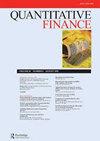Household financial health: a machine learning approach for data-driven diagnosis and prescription
IF 1.4
4区 经济学
Q3 BUSINESS, FINANCE
引用次数: 0
Abstract
AbstractHousehold finances are being threatened by unprecedented social and economic upheavals, including an aging society and slow economic growth. Numerous researchers and practitioners have provided guidelines for improving the financial status of households; however, the challenge of handling heterogeneous households remains nontrivial. In this study, we propose a new data-driven framework for the financial health of households to address the needs for diagnosing and improving financial health. This research extends the concept of healthcare to household finance. We develop a novel deep learning-based diagnostic model for estimating household financial health risk scores from real-world household balance sheet data. The proposed model can successfully manage the heterogeneity of households by extracting useful latent representations of household balance sheet data while incorporating the risk information of each variable. That is, we guide the model to generate higher latent values for households with risky balance sheets. We also show that the gradient of the model can be utilized for prescribing recommendations for improving household financial health. The robustness and validity of the new framework are demonstrated using empirical analyses.Keywords: Household financeFinancial healthHeterogeneityRisk scoringDeep learning Disclosure statementNo potential conflict of interest was reported by the author(s).Notes1 Note that Indicator 4 follows the opposite direction of the other indicators. For Indicators 1 to 3, having a large value would increase financial risk, while it is the opposite for Indicator 4. Hence, stochastic dominance in Indicator 4 should also be interpreted in the opposite way from the other indicators.2 In Appendix C, we used the Bonferroni post-hoc test to assess the significance of the difference in risk information for each of the input variables to RI-HAE.3 To be more precise, the reciprocal of shadow price represents the amount of money required to increase the financial risk score by one unit estimated under first-order approximation because shadow price is a slope of the linear function tangent to RI-HAE.Additional informationFundingThis work was supported by the National Research Foundation of Korea (NRF) grant funded by the Korean government (MSIT) (No. NRF-2022R1I1A4069163 and No. NRF-2020R1C1C1011063).家庭财务健康:数据驱动诊断和处方的机器学习方法
家庭财务正受到前所未有的社会和经济动荡的威胁,包括老龄化社会和缓慢的经济增长。许多研究人员和从业人员为改善家庭财务状况提供了指导方针;然而,处理异构家庭的挑战仍然不容忽视。在这项研究中,我们提出了一个新的数据驱动的家庭财务健康框架,以解决诊断和改善财务健康的需求。本研究将医疗保健的概念延伸至家庭财务。我们开发了一种新的基于深度学习的诊断模型,用于从现实世界的家庭资产负债表数据中估计家庭财务健康风险评分。该模型通过提取家庭资产负债表数据的有用潜在表示,同时结合每个变量的风险信息,成功地管理了家庭的异质性。也就是说,我们引导模型为具有风险资产负债表的家庭产生更高的潜在价值。我们还表明,该模型的梯度可以用于处方建议,以改善家庭财务健康。通过实证分析证明了新框架的鲁棒性和有效性。关键词:家庭财务财务健康异质性风险评分深度学习披露声明作者未报告潜在利益冲突。注1 4号指示灯与其他指示灯方向相反。指标1 ~ 3的数值越大,金融风险就越大;指标4的数值越大,金融风险就越大。因此,指标4中的随机优势也应该以与其他指标相反的方式来解释在附录C中,我们使用Bonferroni事后检验来评估ri - hae的每个输入变量的风险信息差异的显著性更准确地说,影子价格的倒数表示在一阶近似下估计将金融风险评分提高一个单位所需的资金数额,因为影子价格是与RI-HAE相切的线性函数的斜率。本研究由韩国国家研究基金会(NRF)资助,由韩国政府(MSIT)资助(No. 5)。NRF-2022R1I1A4069163nrf - 2020 r1c1c1011063)。
本文章由计算机程序翻译,如有差异,请以英文原文为准。
求助全文
约1分钟内获得全文
求助全文
来源期刊

Quantitative Finance
社会科学-数学跨学科应用
CiteScore
3.20
自引率
7.70%
发文量
102
审稿时长
4-8 weeks
期刊介绍:
The frontiers of finance are shifting rapidly, driven in part by the increasing use of quantitative methods in the field. Quantitative Finance welcomes original research articles that reflect the dynamism of this area. The journal provides an interdisciplinary forum for presenting both theoretical and empirical approaches and offers rapid publication of original new work with high standards of quality. The readership is broad, embracing researchers and practitioners across a range of specialisms and within a variety of organizations. All articles should aim to be of interest to this broad readership.
 求助内容:
求助内容: 应助结果提醒方式:
应助结果提醒方式:


